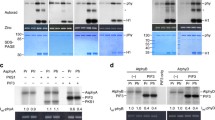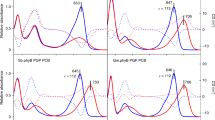Summary
The biochemical mechanism of phytochrome action is unknown. We have examined the proposal, based on sequence similarities to the sensor histidine kinase components of bacterial two-component signaling systems, that the phytochromes may be functional homologs of these kinases. Four amino acids, three highly conserved between the phytochrome and bacterial kinase molecules and the other, the histidine residue putatively the target of autophosphorylation, were changed singly in the oat phytochrome A sequence by in vitro site-directed mutagenesis, and the resultant mutant photo-receptor molecules were assayed for activity by overexpression in transgenic Arabidopsis. Three of the four mutant molecules retained activity equivalent to that of the unmutagenized parent sequence, whereas the fourth mutant could not be evaluated because of low expression. The data show that the former three mutagenized residues are not essential for phytochrome A function in transgenic Arabidopsis, but, because of the negative nature of the results, the possibility cannot be precluded that the photoreceptor functions as a protein kinase independent of these residues.
Similar content being viewed by others
References
Algarra P, Linder S, Thümmler F (1993) Biochemical evidence that phytochrome of the mossCeratodon purpureus is a light-regulated protein kinase. FEBS 315: 69–73
Borthwick HA, Hendricks SB (1960) Photoperiodism in plants. Science 132: 1223–1228
Boylan MT, Quail PH (1989) Oat phytochrome is biologically active in transgenic tomatoes. Plant Cell 1: 765–773
— — (1991) Phytochrome A overexpression inhibits hypocotyl elongation in transgenicArabidopsis. Proc Natl Acad Sci USA 88: 10806–10810
—, Douglas N, Quail PH (1994) Dominant negative suppression of Arabidopsis photoresponses by mutant phytochrome A sequences identifies spatially discrete regulatory domains in the photoreceptor. Plant Cell 6: 449–460
Chang C, Kwok SF, Bleecker AB, Meyerowitz EM (1993)Arabidopsis ethylene-response geneETR1: similarity of product to two-component regulators. Science 262: 539–544
Clack T, Mathews S, Sharrock RA (1994) The phytochrome apoprotein family inArabidopsis is encoded by five genes: the sequences and expression ofPHYD andPHYE. Plant Mol Biol 25: 413–427
Furuya M (1993) Phytochromes: their molecular species, gene families, and functions. Annu Rev Plant Physiol Plant Mol Biol 44: 617–645
—, Song PS (1994) Assembly and properties of holophytochrome. In: Kendrick RE, Kronenberg GHM (eds) Photomorphogenesis in plants, 2nd edn. Kluwer, Dordrecht, pp 105–140
Grimm R, Gast D, Rüdiger W (1989) Characterization of a protein-kinase activity associated with phytochrome from etiolated oat (Avena sativa L.) seedlings. Planta 178: 199–206
Hanelt S, Braun B, Marx S, Schneider-Poetsch H (1992) Phytochrome evolution: a phylogenetic tree with the first complete sequence of phytochrome A of a cryptogamic plant (Selaginella martensii Spring). Photochem Photobiol 56: 751–758
Hanks SK, Quinn AM (1991) Protein kinase catalytic domain sequence database: identification of conserved features of primary structure and classification of family members. In: Hunter T, Sefton BM (eds) Protein phosphorylation, part A, protein kinases: assays, purification, antibodies, functional analysis, cloning, and expression. Academic Press, San Diego, pp 38–62
Hendricks SB, Borthwick HA (1967) The function of phytochrome in regulation of plant growth. Proc Natl Acad Sci USA 58: 2125–2130
Hess JF, Bourret RB, Simon MI (1988a) Histidine phosphorylation and phosphoryl group transfer in bacterial chemotaxis. Nature 336: 139–143
—, Oosawa K, Kaplan N, Simon MI (1988b) Phosphorylation of three proteins in the signaling pathway of bacterial chemotaxis. Cell 53: 79–87
Kendrick RE, Kronenberg GHM (eds) (1994) Photomorphogenesis in plants, 2nd edn. Kluwer, Dordrecht
Kim IS, Bai U, Song PS (1989) A purified 124 kDa oat phytochrome does not possess a protein kinase activity. Photochem Photobiol 49: 319–323
Kolukisaoglu HÜ, Braun B, Martin WF, Schneider-Poetsch HAW (1993) Mosses do express conventional, distantly B-type-related phytochromes: phytochrome ofPhyscomitrella patens (Hedw.). FEBS 334: 95–100
—, Marx S, Wiegmann C, Hanelt S, Schneider-Poetsch HAW (1995) Divergence of phytochrome gene family predates angiosperm evolution and suggests thatSelaginella andEquisetum arose prior toPsilotum. J Mol Evol 41: 329–337
Koshland DE Jr (1993) The two-component pathway comes to eukaryotes. Science 262: 532
Lagarias JC, Wong YS, Berkelman TR, Kidd DG, McMichael RW Jr (1987) Structure—function studies onAvena phytochrome. In: Furuya M (ed) Phytochrome and photoregulation in plants. Academic Press, Tokyo, pp 51–62
McMichael RW Jr, Lagarias JC (1990) Polycation-stimulated phytochrome phosphorylation: is phytochrome a protein kinase? Curr Top Plant Biochem Physiol 9: 259–270
Mathews S, Lavin M, Sharrock RA (1995) Evolution of the phytochrome gene family and its utility for phylogenetic analyses of angiosperms. Ann Missouri Bot Garden 82: 296–321
Mohr H (1966) Differential gene activation as a mode of action of phytochrome 730. Photochem Photobiol 5: 469–483
Okamoto H, Hirano Y, Abe H, Tomizawa K, Furuya M, Wada M (1993) The deduced amino acid sequences of phytochrome fromAdiantum includes consensus motifs presented in phytochrome B from seed plants. Plant Cell Physiol 34: 1329–1334
Ota IM, Varshavsky A (1993) A yeast protein similar to bacterial two-component regulators. Science 262: 566–569
Parkinson JS (1993) Signal transduction schemes of bacteria. Cell 73: 857–871
—, Kofoid EC (1992) Communication modules in bacterial signaling proteins. Annu Rev Genet 26: 71–112
Parks BM, Quail PH (1993)hy8, a new class of Arabidopsis long hypocotyl mutants deficient in functional phytochrome A. Plant Cell 5: 39–48
Pratt LH (1995) Phytochromes: differential properties, expression patterns and molecular evolution. Photochem Photobiol 61: 10–21
—, Cordonnier MM (1989) Photomorphogenesis. In: Smith KC (ed) The science of photobiology, 2nd edn. Plenum, New York, pp 273–304
—, Wampler JE, Rich ESJ (1985) An automated dual-wavelength spectrophotometer optimized for phytochrome assay. Anal Instrument 13: 269–287
—, Cordonnier-Pratt MM, Hauser B, Caboche M (1995) Tomato contains two differentially expressed genes encoding B-type phytochromes, neither of which can be considered an ortholog ofArabidopsis phytochrome B. Planta 197: 203–206
Quail PH (1982) Intracellular location of phytochrome. In: Hélène C, Charlier M, Montenay-Garestier TL (eds) Trends in photobiology. Plenum, New York, pp 485–500
— (1983) Rapid action of phytochrome in photomorphogenesis. In: Mohr H, Shropshire W Jr (eds) Photomorphogenesis. Springer, Berlin Heidelberg New York Tokyo, pp 178–212 [Pirson A, Zimmermann MH (eds) Encyclopedia of plant physiology, vol 16]
— (1991) Phytochrome: a light-activated molecular switch that regulates plant gene expression. Annu Rev Genet 25: 389–409
— (1994a) Phytochrome genes and their expression. In: Kendrick RE, Kronenberg GHM (eds) Photomorphogenesis in plants, 2nd edn. Kluwer, Dordrecht, pp 71–104
— (1994b) Photosensory perception and signal transduction in plants. Curr Opin Gen Dev 4: 652–661
—, Hershey HP, Idler KB, Sharrock RA, Christensen AH, Parks BM, Somers D, Tepperman J, Bruce WB, Dehesh K (1991)phy-Gene structure, evolution, and expression. In: Thomas B, Johnson CB (eds) Phytochrome properties and biological action. Springer, Berlin Heidelberg New York Tokyo, pp 13–38
—, Boylan MT, Parks BM, Short TW, Xu Y, Wagner D (1995) Phytochromes: photosensory perception and signal transduction. Science 268: 675–680
Rogers SG, Klee HJ, Horsch RB, Fraley RT (1987) Improved vectors for plant transformation: expression cassette vectors and new selectable markers. Methods Enzymol 153: 253–277
Schneider-Poetsch HAW, Braun B (1991) Proposal on the nature of phytochrome action based on the C-terminal sequences of phytochrome. J Plant Physiol 137: 576–580
— —, Marx S, Schaumburg A (1991) Phytochromes and bacterial sensor proteins are related by structural and functional homologies. FEBS J 281: 245–249
—, Marx S, Kolukisaoglu HU, Hanelt S, Braun B (1994) Phytochrome evolution: phytochrome genes in ferns and mosses. Physiol Plant 91: 241–250
Sharrock RA, Quail PH (1989) Novel phytochrome sequences inArabidopsis thaliana: structure, evolution, and differential expression of a plant regulatory photoreceptor family. Genes Dev 3: 1745–1757
Smith H (1970) Phytochrome and photomorphogenesis in plants. Nature 227: 665–668
— (1992) The ecological functions of the phytochrome family. Clues to a transgenic programme of crop improvement. Photochem Photobiol 56: 815–822
— (1994) Sensing the light environment: the functions of the phytochrome family. In: Kendrick RE, Kronenberg GHM (eds) Photomorphogenesis in plants, 2nd edn. Kluwer, Dordrecht, pp 377–416
—, Whitelam GC (1990) Phytochrome, a family of photoreceptors with multiple physiological roles. Plant Cell Environ 13: 695–707
Somers DE, Sharrock RA, Tepperman JM, Quail PH (1991) Thehy3 long hypocotyl mutant of Arabidopsis is deficient in phytochrome B. Plant Cell 3: 1263–1274
Stock JB, Lukat GS, Stock AM (1991) Bacterial chemotaxis and the molecular logic of intracellular signal transduction networks. Annu Rev Biophys Biophys Chem 20: 109–136
Thümmler F, Dufner M, Kreisl P, Dittrich P (1992) Molecular cloning of a novel phytochrome gene of the mossCeratodon purpureus which encodes a putative light-regulated protein kinase. Plant Mol Biol 20: 1003–1017
—, Algarra P, Fobo GM (1995) Sequence similarities of phytochrome to protein kinases: implication for the structure, function and evolution of the phytochrome gene family. FEBS Lett 357: 149–155
Valvekens D, Van Montagu M, van Lijsebettens M (1988)Agrobacterium tumefaciens-mediated transformation ofArabidopsis thaliana root expiants by using kanamycin selection. Proc Natl Acad Sci USA 85: 5536–5540
Vierstra RD (1993) Illuminating phytochrome functions. Plant Physiol 103: 679–684
Wong YS, McMichael RW Jr, Lagarias JC (1989) Properties of a polycation-stimulated protein kinase associated with purifiedAvena phytochrome. Plant Physiol 91: 709–718
Xu Y, Parks BM, Short TW, Quail PH (1995) Missense mutations define a restricted segment in the COOH-terminal domain of phytochrome A critical to its regulatory activity. Plant Cell 7: 1433–1443
Author information
Authors and Affiliations
Corresponding author
Additional information
Dedicated to Professor Eldon H. Newcomb in recognition of his contributions to cell biology
Rights and permissions
About this article
Cite this article
Boylan, M.T., Quail, P.H. Are the phytochromes protein kinases?. Protoplasma 195, 12–17 (1996). https://doi.org/10.1007/BF01279182
Received:
Accepted:
Issue Date:
DOI: https://doi.org/10.1007/BF01279182




